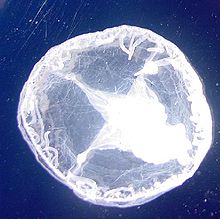- Craspedacusta sowerbyi
-
Freshwater Jelly 
Scientific classification Kingdom: Animalia Subkingdom: Eumetazoa Phylum: Cnidaria Subphylum: Medusozoa Class: Hydrozoa Order: Limnomedusae Family: Olindiidae Genus: Craspedacusta Species: C. sowerbyi Binomial name Craspedacusta sowerbyi
Lankester, 1880Synonyms Craspedacusta sowerbii (lapsus)
 A specimen in a farming pond (Upstate New York).
A specimen in a farming pond (Upstate New York).
Craspedacusta sowerbyi is a freshwater jellyfish in the phylum Cnidaria. Since it is classified as a hydrozoan, it is one of many jellyfish that are also known as hydromedusae ("medusa" is another word for jellyfish). Hydromedusan jellyfish differ from scyphozoan jellyfish because they have a muscular, shelf-like structure called a velum on the ventral surface, attached to the bell margin. C. sowerbyi is found throughout the world in bodies of fresh water.
Contents
Form
C. sowerbyi medusae are about 20–25 mm in diameter, somewhat flatter than a hemisphere, and very delicate, when fully grown. They have a whorl of up to 400 tentacles tightly packed around the bell margin. Hanging down from the center of the inside of the bell is a large stomach structure called a manubrium, with a mouth-opening with four frilly lips. Circulation of nutrients is facilitated by four radial canals which originate at the edges of the stomach (manubrium), and which are also connected to a ring canal, located near the bell margin. Most of the body is transparent or translucent, with a whitish or greenish tinge. The (usually) four large flat sex organs (gonads) are attached to the four radial canals, and are usually opaque white. The many tentacles each contain thousands of cells called cnidocytes, which contain nematocysts (also known as cnidocysts), and are used to capture prey and pass it to the mouth. Food is taken in the mouth opening, and waste is finally expelled out of the same opening.
Habitat and Distribution
C. sowerbyi is usually found in calm, freshwater reservoirs, lakes, impoundments, gravel pits or quarries. They have also been seen in river systems such as the Allegheny River, the Ohio River and the Tennessee River in the United States and the Wang Thong River of Thailand. They prefer standing water, and are not generally seen in fast flowing streams or rivers.
C. sowerbyi has a global distribution - it has been found in countries on almost every continent (so far there are no reports from South America) and nearly every state in America (no reports yet from Montana, Wyoming, North Dakota, South Dakota, Alaska or Hawaii) and most provinces in Canada (no reports yet from Alberta, Saskatchewan).[1]
C. Sowebyi has also been recently found in the Cauvery river of Karnataka, India [2] [3], and backwaters of the Hemavathi River in Hassan in Karnataka
Recently, Dr. Marco Antonio Moreno León reported the first record of the freshwater jellyfish Craspedacusta sowerbyi (Lankester 1880) in Mexico; the jellyfish was collected in Adolfo Lopez Mateos (ALM) reservoir, one of the main reservoirs in Sinaloa State NW in Mexico. This report of the population of C. sowerbyi represents an exceptional case of freshwater jellyfish at this latitude on the American Continent.[citation needed]
The medusa's appearance is sporadic and unpredictable from year to year. It is not uncommon for C. sowerbyi to appear in a body of water where it had never been documented before, in very large numbers, and its appearance may even be reported on the local news.
During the abnormal heat in the summer 2010 in Russia sightings of C. sowerbyi were reported in the Moscow river.[4]
On August 21st 2010, C. sowerbyi was spotted and captured on the northwest corner of Falcon Lake in Manitoba, Canada. Scientists believe this is due to a recent heatwave in the Whiteshell Provincial Park area. It is proposed the C. sowerbyi came to Falcon Lake on waterfowl originating from Star Lake, Manitoba, Canada. Falcon Lake along with Star Lake remain the only two confirmed sightings of C. sowerbyi in Manitoba.[5]
Feeding
C. sowerbyi is a predator on zooplankton including daphnia and copepods. Prey is caught with their stinging tentacles. Drifting with its tentacles extended, the jelly waits for suitable prey to touch a tentacle. Once contact has been made, nematocysts on the tentacle fire into the prey, injecting poison which paralyzes the animal, and the tentacle itself coils around the prey. The tentacles then bring the prey into the mouth, where it is released and then digested.
Natural history
C. sowerbyi begins life as a tiny polyp, which lives in colonies attached to underwater vegetation, rocks, or tree stumps, feeding and asexually reproducing during spring and summer. Some of these offspring are the sexually reproducing medusae. Fertilized eggs develop into small ciliated larvae called planula. The planula then settle to the bottom, and develop into polyps. However, the majority of C. sowerbyi populations existing in the United states are either all male or all female, so there is no sexual reproduction in those populations. During the cold winter months, polyps contract and become resting bodies, called podocysts. It is believed that podocysts are transported by aquatic plants or animals to other bodies of water. Once conditions become favorable, they develop into polyps again.
References
- ^ Peard, Terry. "Distribution of the freshwater jellyfish". http://www.jellyfish.iup.edu/US.html. Retrieved 2008-08-11.
- ^ "New site for C. Sowerbyi". http://www.ias.ac.in/currsci/10nov2010/1165a.pdf.
- ^ "Photographs of C. Sowerbyi in India". http://amoghavarsha.com/journal/2009/02/09/freshwater-jellyfish-craspedusta-sowerbii/.
- ^ "Man nets seven jellyfish in Moscow River". RIA Novisti. http://rianovosti.com/strange/20100803/160057814.html. Retrieved 2010-08-04.
- ^ "Families find Manitoba's first jellyfish". Winnipeg Free Press. http://www.winnipegfreepress.com/breakingnews/families-find-manitobas-first-jellyfish-101780128.html. Retrieved 2010-08-21.
External links
- http://nas.er.usgs.gov/queries/FactSheet.asp?speciesID=1068 USGS' page about C. sowerbyi
- http://www.jellyfish.iup.edu An authoritative and detailed website about Craspedacusta sowerbyi
- http://www.microscopy-uk.org.uk/mag/artdec99/fwjelly2.html
- http://www.microscopy-uk.org.uk/mag/artnov99/fwjelly.html
- Kaeng Bang Rachan at Tourism Authority of Thailand (reference to freshwater jellyfish in the Wang Thong River in Thailand)
- GLANSIS Species FactSheet
Categories:- Olindiasidae
Wikimedia Foundation. 2010.
